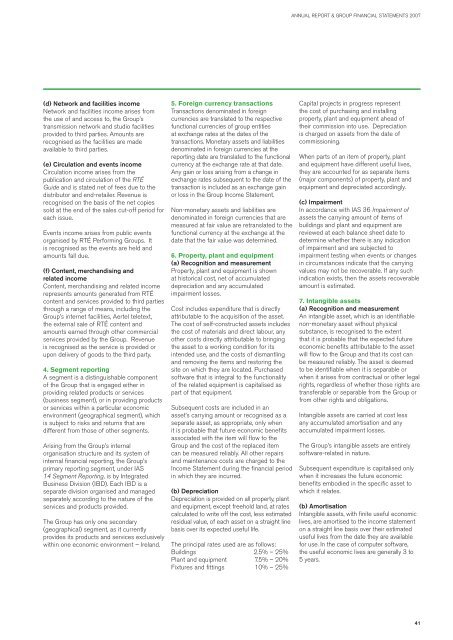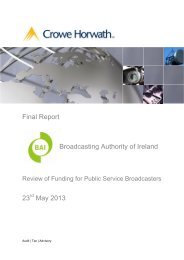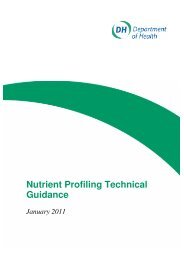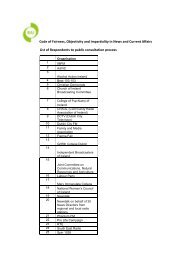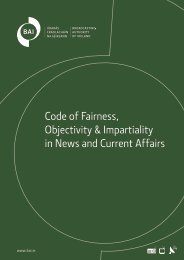RADIO TELEFÍS ÉIREANNStatement of Accounting Policies1. Basis of accounting(a) Reporting entityRTÉ is a statutory corporation establishedunder the Broadcasting Authority Act, 1960and is domiciled in Ireland. The consolidatedfinancial statements of RTÉ as at andfor the year ended 31 December 2007comprise of the statutory corporation andall entities controlled by it (together referredto as the “Group”).(b) Statement of complianceThe RTÉ and Group financial statementshave been prepared in accordance withInternational Financial Reporting Standards(IFRS) and their interpretations approvedby the International Accounting StandardsBoard (IASB) as adopted by the EuropeanUnion (EU) that are effective for theyear ended 31 December 2007 and areapplied in accordance with the provisionsof broadcasting legislation. The Group hasalso elected to present both its consolidatedand RTÉ parent entity financial statementsin accordance with the provisions of theIrish Companies Acts, 1963 to 2006 in sofar as necessary to give a true and fair view.Accordingly RTÉ’s parent balance sheet,statement of cash flows and statement oftotal recognised income and expense havealso been presented with the consolidatedfinancial statements as would ordinarily berequired by the Irish Companies Acts 1963to 2006.These consolidated financial statementsare the Group’s first financial statementsto be prepared in accordance with IFRS.An explanation of how the transition toIFRS has impacted the reported financialposition and financial performance of theGroup is provided in note 24 to the financialstatements.(c) Basis of preparationThe RTÉ and Group financial statements havebeen prepared on the historical cost basisexcept for derivative financial instrumentswhich are measured at fair value.The Group financial statements are preparedin Euro, rounded to the nearest thousand,which is the functional currency of all theGroup entities.The preparation of financial statements inconformity with IFRSs requires managementto make judgements, estimates andassumptions that affect the application ofaccounting policies and reported amounts ofassets, liabilities, income and expenses. Actualresults may differ from these estimates.Estimates and underlying assumptions arereviewed on an ongoing basis. Revisions toaccounting estimates are recognised in theperiod in which the estimates are revisedand in any future periods effected. Thekey areas involving significant judgementor complexity, or areas where assumptionsand estimates are significant to the Group’sfinancial statements relate primarily to thevaluation of the defined benefit pensionscheme, financial instruments, provisions,and deferred tax and are documented in therelevant accounting policies below and inthe related notes. The accounting policiesset out below have been applied consistentlyby group entities and by RTÉ, whereapplicable, to all periods presented in theseconsolidated and RTÉ financial statementsand in preparing the opening IFRS balancesheet at 1 January 2006.2. Basis of consolidation(a) SubsidiariesThe Group financial statements include thefinancial statements of RTÉ and all of itssubsidiary entities drawn up to 31 Decembereach year. Subsidiaries are entities controlledby the Group. Control exists when the Grouphas the power to govern the financial andoperating policies of an entity so as to obtainbenefits from its activities. The financialstatements of subsidiaries are included inthe consolidated financial statements fromthe date that control commences until thedate that control ceases.(b) Seirbhísí Theilifís naGaeilge TeorantaTeilifís na Gaeilge was established as anindependent statutory entity to operatethe television service broadcast as TG4on 1 April 2007, pursuant to the Teilifís naGaeilge (Establishment Day) Order 2007,which implemented the relevant provisionsof the Broadcasting Act 2001. Prior to thisseparation, the operations of TG4 had beenconducted through Seirbhísí Theilifís naGaeilge Teoranta, a wholly controlled RTÉsubsidiary. The operations of TG4 up to31 March 2007 have been classified as adiscontinued operation in accordance withIFRS 5 Non-Current Assets Held for Saleand Discontinued Operations within theresults as presented for the Group.A discontinued operation is a componentof the Group’s business that representsa separate major line of business orgeographical area of operations that hasbeen disposed of or is held for sale, or is asubsidiary acquired exclusively with a viewto resale. Classification as a discontinuedoperation occurs upon disposal or whenan operation meets the criteria to beclassified as held for sale, if earlier. Whenan operation is classified as a discontinuedoperation, the comparative income statementis re-presented as if the operation hasbeen discontinued from the start of thecomparative period.(c) Transactions eliminatedon consolidationIntra-group balances and transactions,and any realised income and expensesarising from intra-group transactions, areeliminated in preparing the consolidatedfinancial statements.3. Revenue recognition(a) Recognition principlesRevenue, which excludes VAT andtransactions between companies in theGroup, comprises income arising fromLicence Fees, advertising sales, sponsorship,the use of the Group’s facilities andtransmission network, circulation and eventsincome, and content, merchandising andrelated income. Revenue is stated net of anysettlement and volume discounts.In general, revenue is recognised to theextent that recovery is probable, it is subjectto reliable measurement, it is probable thateconomic benefits will flow to the Groupand that the significant risks and rewards ofownership has transferred to the buyer.(b) Licence Fee revenueLicence Fee revenue payable by theDepartment of Social and Family Affairs(DSFA) on behalf of individuals eligible for a“free” Television Licence is collected directlyby the Department of Communications,Energy and Natural Resources (DCENR)from DSFA. All other Licence Fee revenueis collected by An Post and paid over toDCENR, net of collection costs. DCENRmakes a non-repayable “grant-in-aid” toRTÉ from these Licence Fees collected, asprovided in Section 8 of the BroadcastingAuthority (Amendment) Act, 1976, in lieuof the amounts collected by An Post, netof collection costs and a 5% levy to theSpecial Broadcasting Fund, together with theamounts paid to it by DSFA.Licence Fee revenue is recognised whenknown to be receivable.(c) Advertising and sponsorship incomeTelevision advertising income is recognisedon delivery of a campaign. All otheradvertising income is recognised ontransmission/publication. Advertisingincome is stated net of agency commissions.Sponsorship income is recognised evenlyover the life of the sponsored programme,publication etc.40
ANNUAL REPORT & GROUP FINANCIAL STATEMENTS 2007(d) Network and facilities incomeNetwork and facilities income arises fromthe use of and access to, the Group’stransmission network and studio facilitiesprovided to third parties. Amounts arerecognised as the facilities are madeavailable to third parties.(e) Circulation and events incomeCirculation income arises from thepublication and circulation of the RTÉGuide and is stated net of fees due to thedistributor and end-retailer. Revenue isrecognised on the basis of the net copiessold at the end of the sales cut-off period foreach issue.Events income arises from public eventsorganised by RTÉ Performing Groups. Itis recognised as the events are held andamounts fall due.(f) Content, merchandising andrelated incomeContent, merchandising and related incomerepresents amounts generated from RTÉcontent and services provided to third partiesthrough a range of means, including theGroup’s internet facilities, Aertel teletext,the external sale of RTÉ content andamounts earned through other commercialservices provided by the Group. Revenueis recognised as the service is provided orupon delivery of goods to the third party.4. Segment reportingA segment is a distinguishable componentof the Group that is engaged either inproviding related products or services(business segment), or in providing productsor services within a particular economicenvironment (geographical segment), whichis subject to risks and returns that aredifferent from those of other segments.Arising from the Group’s internalorganisation structure and its system ofinternal financial reporting, the Group’sprimary reporting segment, under IAS14 Segment Reporting, is by IntegratedBusiness Division (IBD). Each IBD is aseparate division organised and managedseparately according to the nature of theservices and products provided.The Group has only one secondary(geographical) segment, as it currentlyprovides its products and services exclusivelywithin one economic environment – Ireland.5. Foreign currency transactionsTransactions denominated in foreigncurrencies are translated to the respectivefunctional currencies of group entitiesat exchange rates at the dates of thetransactions. Monetary assets and liabilitiesdenominated in foreign currencies at thereporting date are translated to the functionalcurrency at the exchange rate at that date.Any gain or loss arising from a change inexchange rates subsequent to the date of thetransaction is included as an exchange gainor loss in the Group Income Statement.Non-monetary assets and liabilities aredenominated in foreign currencies that aremeasured at fair value are retranslated to thefunctional currency at the exchange at thedate that the fair value was determined.6. Property, plant and equipment(a) Recognition and measurementProperty, plant and equipment is shownat historical cost, net of accumulateddepreciation and any accumulatedimpairment losses.Cost includes expenditure that is directlyattributable to the acquisition of the asset.The cost of self-constructed assets includesthe cost of materials and direct labour, anyother costs directly attributable to bringingthe asset to a working condition for itsintended use, and the costs of dismantlingand removing the items and restoring thesite on which they are located. Purchasedsoftware that is integral to the functionalityof the related equipment is capitalised aspart of that equipment.Subsequent costs are included in anasset’s carrying amount or recognised as aseparate asset, as appropriate, only whenit is probable that future economic benefitsassociated with the item will flow to theGroup and the cost of the replaced itemcan be measured reliably. All other repairsand maintenance costs are charged to theIncome Statement during the financial periodin which they are incurred.(b) DepreciationDepreciation is provided on all property, plantand equipment, except freehold land, at ratescalculated to write off the cost, less estimatedresidual value, of each asset on a straight linebasis over its expected useful life.The principal rates used are as follows:Buildings 2.5% – 25%Plant and equipment 7.5% – 20%Fixtures and fittings 10% – 25%Capital projects in progress representthe cost of purchasing and installingproperty, plant and equipment ahead oftheir commission into use. Depreciationis charged on assets from the date ofcommissioning.When parts of an item of property, plantand equipment have different useful lives,they are accounted for as separate items(major components) of property, plant andequipment and depreciated accordingly.(c) ImpairmentIn accordance with IAS 36 Impairment ofassets the carrying amount of items ofbuildings and plant and equipment arereviewed at each balance sheet date todetermine whether there is any indicationof impairment and are subjected toimpairment testing when events or changesin circumstances indicate that the carryingvalues may not be recoverable. If any suchindication exists, then the assets recoverableamount is estimated.7. Intangible assets(a) Recognition and measurementAn intangible asset, which is an identifiablenon-monetary asset without physicalsubstance, is recognised to the extentthat it is probable that the expected futureeconomic benefits attributable to the assetwill flow to the Group and that its cost canbe measured reliably. The asset is deemedto be identifiable when it is separable orwhen it arises from contractual or other legalrights, regardless of whether those rights aretransferable or separable from the Group orfrom other rights and obligations.Intangible assets are carried at cost lessany accumulated amortisation and anyaccumulated impairment losses.The Group’s intangible assets are entirelysoftware-related in nature.Subsequent expenditure is capitalised onlywhen it increases the future economicbenefits embodied in the specific asset towhich it relates.(b) AmortisationIntangible assets, with finite useful economiclives, are amortised to the income statementon a straight line basis over their estimateduseful lives from the date they are availablefor use. In the case of computer software,the useful economic lives are generally 3 to5 years.41


